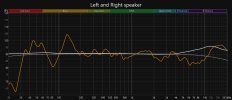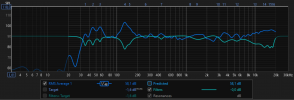This will require some experimentation, there are no rules written in stone, so there will naturally be some different opinions.
If you follow the approach illustrated in dr. Toole's book, you should not EQ based on the in-room-response above the rooms transition frequency; which is typically in the 200-400Hz range for most residential rooms.
Getting the exact frequency is difficult but ultimately also not that important, because the transition from perceiving the combined room+loudspeaker response (at low frequencies) to hearing the loudspeaker direct sound and room sound as two separate phenomena (in higher frequencies) is gradual anyway.
This is also why I'd always recommend to use 'variable' smoothing when calculating EQ filters - it will give no smoothing at low frequencies (where you need to correct peaks) but do a lot of smoothing at high frequencies (which you should not touch, or possibly only with low-Q/wide filters). I also prefer to use MMM instead of sweep measurements as basis for EQ - IMHO MMM is quicker and directly gives results that are comparable to anechoic PIR (above approx. 1kHz).
Regarding which peaks/dips to correct and which not I'd say the following:
- You should not correct any dips with EQ; ideally you should instead optimize loudspeaker and MLP placement to minimize them. Note that the dips are mainly caused by the distance of loudspeakers from nearby walls/ceiling/floor - i.e. SBIR.
- Peaks should be brought down by PEQ, and I'd suggest to EQ all peaks under about 300Hz. You can probably get similarly good-sounding results by EQ-ing only the big peaks (as those are the most audibly offending) - e.g. in my destop system I use only 3-bands of PEQ and still get a good result - but if you have the option to run more bands of PEQ it's definitely worth to try.
- Experiment a bit with target curves - namely try a (slight) downward slope and/or a small boost <200Hz instead of a fully flat curve. This is to account for the natural rising directivity (with frequency) of conventional front-firing loudspeakers.
Perhaps you will also find some of these posts useful:
- On SBIR and tips for improving loudspeaker/subwoofer positioning
- How to do MMM and calculate EQ in REW
- Room EQ FAQ



